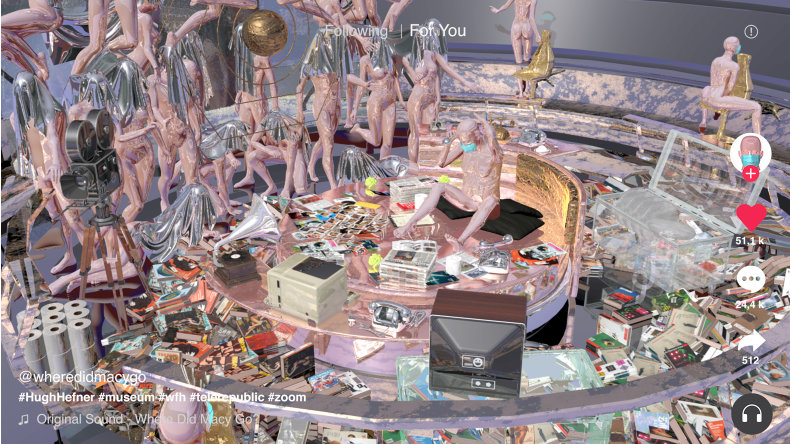Robert C. Morgan reviews the group exhibition Alienation ? at Eli Klein Gallery in New York City. Curated by Phil Cai, the exhibition highlights the work of eight contemporary Chinese artists based in New York City including Ziyang Wu.
Alienation ?
By Robert C. Morgan
Alienation ? is the title of an exhibition at the Eli Klein Gallery, located on the West Street highway and starkly removed from other gallery outposts that promote avant-garde art in Manhattan. Its isolation undoubtedly informs the immediacy of its attraction. By transforming the single word of the show’s title into a question, the gallery provokes viewers to come to terms with its meaning. For many, the word alienation might read as an overused Marxist epithet, or an allusion to the ideas we could encounter in Camus or Sartre. But despite the title of this exhibition, there are relatively few hardened cases of alienation on display here. Each work appears to have its special place, and each retains a message as to what is meant not only by the presence of the work, but by the questions raised as to the work’s importance. This is a calibrated offering whereby each object or image is made to stand its own ground.
Curated by Phil Cai, the current exhibition includes works by eight contemporary Chinese artists based in New York City. Within this context, Cai decisively touches on Marxist ideas without insisting on a theoretical exhibition. Rather, he effectively reveals the diversity of art currently being made by artists who have left the People’s Republic of China, as a kind of reference to Marx’s idea “that the working class will first be alienated from what they produce.” The necessity of having this curatorial diversity—thanks to Cai’s aesthetic clarity and historical understanding—is essential. That is to say, the curatorial aspect embedded in this exhibition is not directly political, but is a highly conscious effort to show viewers what is necessary in order to maintain aesthetic clarity on a global scale.
Keep in mind, these are Chinese artists working outside the boundaries of their state, coming to terms with an inebriate mixture of art and politics from an entirely new, often fraught, point of reference. Here I would emphasize the role of Li Xiaofei, who in his major video, I Am the People_2(2020), gives direction to the other artists on display by suggesting they have all been cast in the role of productionists.
Upon entering this poignantly engaging exhibition, one may slowly begin to grasp the qualitative fundaments made present. The scale of each work seems to hold space, creating an openness of access in which the works play a necessary and definitive role. Groupings on the sidewalls appear in balance with one another: a coalition of works is assembled on each side, bracketing others hung on the impressive rear walls. Whether painting, photography, or video, the placement of these works reveals open space rather than crowded premises.
The abstract paintings of Feng Lianghong and Shen Chen give visual readings on adjacent walls. In each case, the close spatial relationship of the paintings may suggest they appear altered given their insular positioning—a kind of solidarity that might be understood in Marxist terms. Still, it is unlikely. In past decades, such readings may have been possible, but less so from the perspective of post-Tiananmen Square.
The works included in Alienation ? vary on many levels, some with considerable density. Information is the content in several of these works, as suggested in Li Xiaofei’s contributions, titled My Locker-01 (2020, archival pigment print) and I am the People_02 (2020, single channel color video with sound). The content that emerges from these works either leans toward the perfunctory or contributes readily to a self-prodding feeling of isolation.
Overall, the curatorial theme of Alienation ? juxtaposes community with immunity, suggesting paradoxical closeness between two opposed ways of thought. This contradiction can be found throughout the exhibition, from Wu Ziyang’s Where Did Macy Go? (2020, color digital animated video with sound) to Li Shan’s Bio Inquiry 1 and 2 (both 2020, watercolor on cardboard). In each case, the primitive and seductive aspects of the work emerge from psychic changes brought about by anonymity, formulating desire on the levels of alienation and virtuality. Where does this seduction stop and how does it begin? It is now omnipresent, as our sense of desire attaches to things we have been deceived into thinking are real.
One of the major questions Alienation ? puts forth focuses on the impact of information at the current moment, as the works in this show strive to show us where the circulation of information begins and where it ends. One response to this dilemma might be to acknowledge that we are at the mercy not of what we do not know, but of the desire for what we believe we should know, whether or not it is relevant or sustainable. With all due respect to several of the extraordinary artists included in this exhibition, one cannot escape the feeling of alienation taking charge of our identity.


